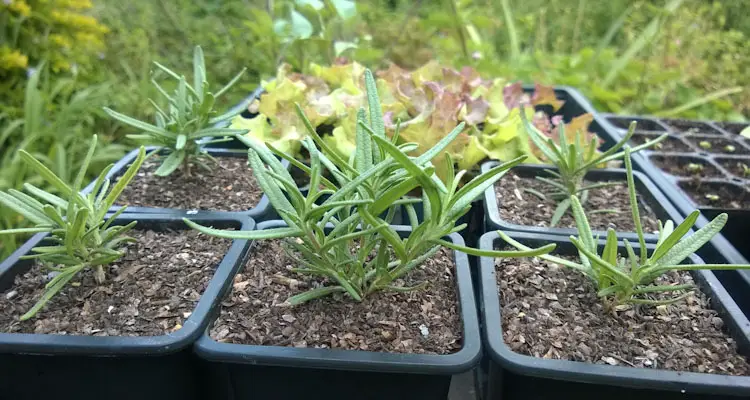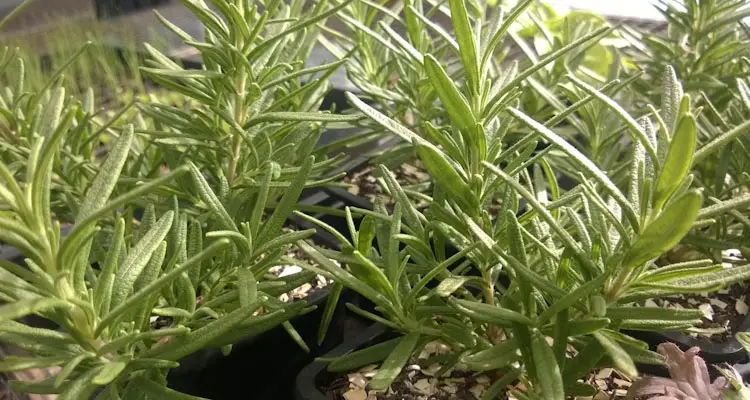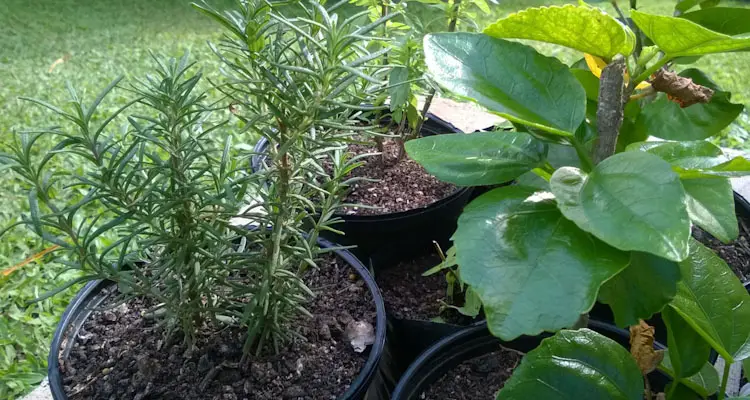Have the lower leaves of your Rosemary plants started to turn brown? This is an early sign that your plants need some attention.
Rosemary plants are robust and need little maintenance to thrive. Yet, their bushy growth, and unsuitable conditions, can be detrimental to the plant.

In this article, we will discuss 9 tips you can use to care for your Rosemary plants. We will also include different steps to rescue your plants, if possible.
1. Start New Plants From Time To Time
Firstly, Rosemary plants are unpredictable. Some will last over a decade, while others can die despite the best care. As a result, you should create new plants ever so often.
Ideally, you should propagated a few cuttings whenever you prune the plant. You can transplant these into the ground, but keep at least one from each batch in a container.
Potted Rosemary plants also make great gifts. The best part is that you can always get a cutting from a friend if your plants die. Please don’t ask me how I know.

2. Prune Plants Often To Encourage New Growth
Did you know that Rosemary plants do not produce new shoots from the woody section of their stems? As a result, the plant can die if you cut it there. To prevent this:
- Trim the “semi-hardwood” section of the plant, leaving about 4 sets of leaves.
- Avoid cutting into the “old wood”, unless you want to kill the plant.
It best to prune your rosemary plants at least once yearly. This slows the advance of the woody stem and encourages new growth, resulting in a bushier plant.
3. Ensure Plants Receive At Least 6 Hours of Sunlight
Lack of sunlight is one of the main reasons why Rosemary plants die. This applies even more to plants grown indoors.
Ensure that your Rosemary plants receive at least 6 hours of direct sunlight daily. Prune trees that create harsh shadows. Or transplants to more well-lit areas.
You must acclimate your Rosemary plant if you wish to carry them indoors. Please do this by gradually exposing them to poorly lit environments over time.

4. Plant In Well-drained Or Dry Sandy Soil
Rosemary plants are native to dry, rocky regions. So, it should be no surprise that they prefer well-drained, sandy, or loamy soils.
As a result, you should ensure that you choose a well-drained area. If your garden is heavy clay, you must amend the soil with organic matter.
Transplant your Rosemary into suitable garden pots, especially if the garden soil cannot drain out. Use a well-drained potting mix to ensure your plants are free to grow.
5. Check Often For Signs Of Diseases
Did you see any white powder on your Rosemary plant leaves? This is usually an early sign of Powdery mildew. To manage this:
- Space your plants to encourage air circulation.
- Prune some branches if necessary.
- Avoid wetting the leaves of plants during cool, humid weather.
Studies suggest that mixing 2 parts milk with 3 part water effectively treats Powdery Mildew. Yet, I’ve had mixed results using this method, due in part to our weather.

6. Transplant the Entire Plant To Different Locations
Have your plants started to wilt without any apparent reason? Do you see black and white rings around the lower root? Is the ground soggy? If yes, then you’ll need to act fast.
- Uproot your Rosemary plant and inspect the roots.
- Prune any dying, infected, or soft-looking roots.
- Transplant the plant into a large container or a different part of the garden.
You can save your plants if you act early enough. But, if it is a severe case of Root rot, please discard the plant to avoid infecting other areas.
7. Choose Varieties Better Suited To Your Climate
Most varieties of Rosemary are well adapted to their native Mediterranean temperatures. These range from 90°F summer days to 40°F winter nights.
You should choose Rosemary varieties that grow best in your region. If not, there is little that you can do when the plant goes into its natural cycle.
This was a hard lesson I had to learn, looking at my French Rosemary plants shrivel up and die. Still, since then, we’ve had much success, except during prolonged rainy seasons.

8. Water Only When Soil Dries Out
Fun Fact: Rosemary plants can flourish for up to two weeks without water or precipitation. In fact, they prefer this, and the proof is in the flavor.
In short, you should water rosemary plants once every 1 to 2 weeks if there is no rain. Water plants more often during prolonged dry spells or if planted in small pots.
That said, cuttings need frequent watering until they have established their root system. Please do not allow these to dry out or risk losing them.

9. Fertilize Rosemary Plants During Rapid Growth
The belief that Rosemary is a light feeder can be misleading. Rosemary plants need nutrients like any other plants. But, the amount will differ based on their stage of growth.
Ideally, you should fertilize Rosemary during warmer times of the year to assist growth. Use compose or other balanced, solid organic fertilizers.
Microorganisms will break down organic matter and provide plants with the necessary nutrients. In doing so, you will not have to worry about adding too much fertilizer.
How To Care For Rosemary Plants In Pots?
It’s much easier to care for Rosemary plants in containers than in the ground. In fact, they grow much better without too much interference. However, there are some things you’ll need to remember.
- Ensure plants receive enough sunlight, but protect them from excessive rainfall.
- Prune and repot rosemary plants periodically. Remove the lower half of the rootball, if they are becoming pot bound..
- Water plants, when necessary. However, you should allow the pot to dry out between watering.
- Do not mist plants during rainy or winter seasons. The extra moisture will encourage the formation of powdery mildew. Use a fan if necessary to improve air circulation.
Over time you’ll get the hang of caring for your Rosemary plants and adjust to suit. Did we miss anything? Let us know!

Related Questions
1. Do Rosemary Plants Need Direct Sunlight?
Yes, Rosemary plants need at least 6 hours of direct sunlight daily. But they can adapt to survive on as little as 4 hours of light if necessary.
2. Does Rosemary Need To Be Cut Back Hard?
Rosemary plants need pruning at least once per year. This stimulates growth and should be done at the beginning of the growing season. However, avoid cutting into the woody stem since it does not grow new shoots.
References
1. Pennsylvania State University. Rosemary – Common Pests And Diseases. plantvillage.psu.edu. Accessed December, 2022
2. University Of Connecticut. Compost Tea And Milk To Suppress Powdery Mildew On Pumpkins. [PDF] Accessed December 2022
3. Michigan State University Extension. Rosemary: The Herb With Winter Problems. canr.msu.edu. Accessed December 2022
4. The Daily Eco. Why Is My Rosemary Drying (3 Reasons And How To Avoid It). [Video] YouTube. Uploaded June 11, 2021
5. Grow Something Green. Rosemary Care – How Not To Kill Rosemary In Tropical Weather. [Video] Youtube. Uploaded June 19, 2021
